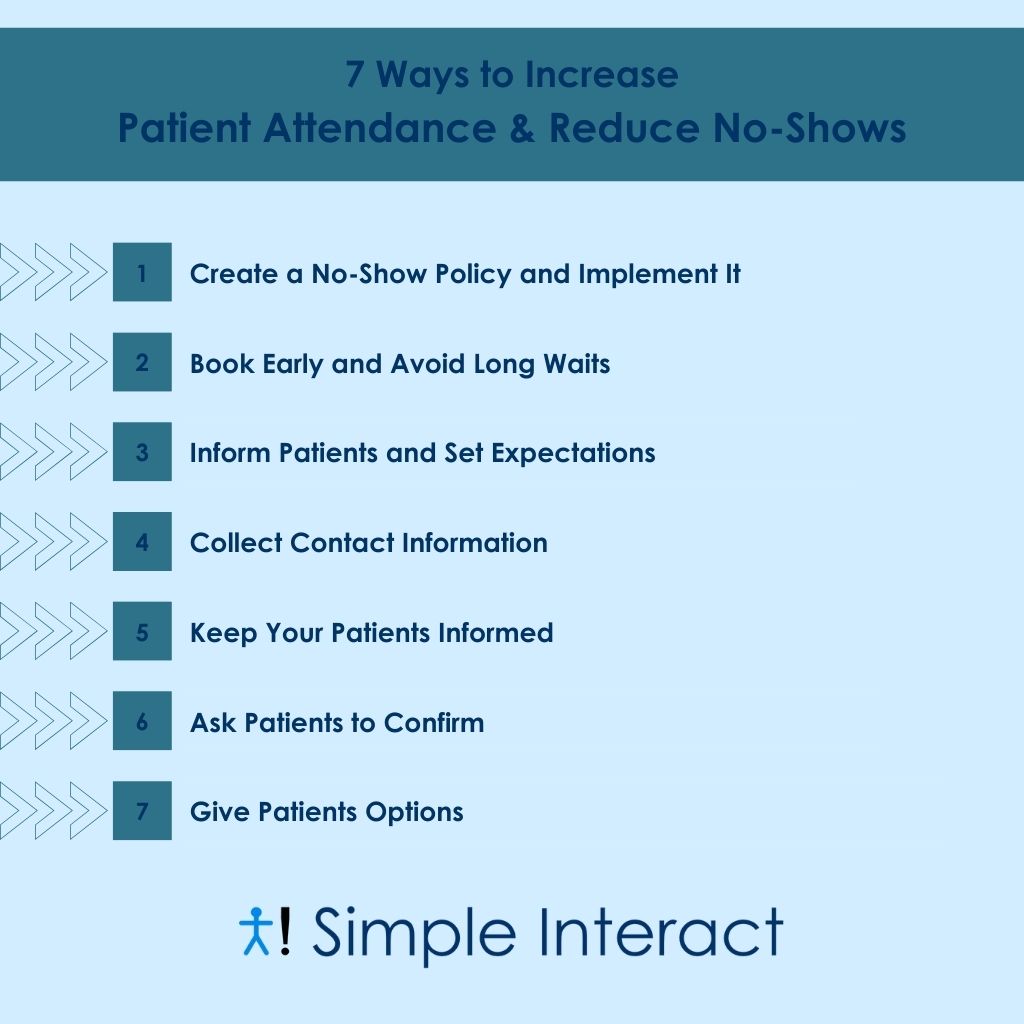7 Ways to Increase Patient Attendance and Reduce No-Shows

The purpose of a medical practice is to provide quality health care services to the people who need them. However, your practice is also a business, and if it isn’t well run, you’re not only hurting your bottom line — you’re hurting your staff and your patients.
One indication of a well-run business is consistent patient attendance with a low percentage of no-shows.
Patient no-shows can have a huge negative impact on your practice. Not only is a no-show appointment detrimental to the patient’s health because they aren’t coming to get the care they need, but it’s also an unutilized slot for which resources have already been reserved (your staff, the room, the provider, etc.) and may be wasted.
If no-show appointments are running rampant within your practice and aren’t within a reasonable margin, you’ve probably already paid a huge cost.
For years, medical practices have scrambled to find the most effective ways to reduce no-shows. After working with hundreds of providers for nearly a decade, Simple Interact has found several proven strategies to reduce them.
In this post, you’ll learn how to reduce no-show appointments with 7 simple tips.
How to Reduce No-Show Appointments
Tip #1: Create a No-Show Policy and Implement It
At the bare minimum, every practice needs to have a no-show policy and implement it consistently. Otherwise, it’s a free-for-all: You aren’t setting expectations for your practice, and you aren’t training your patients to value and respect your time.
Some practices charge a fee when patients fail to show up for scheduled appointments. Of course, collecting these fees can be a hassle and can create resentment in your patients, especially those who believe they had a good reason for not showing up.
For busy practices, a proven alternative is to automatically cancel appointments for patients who fail to confirm by a certain window of time, such as 48 hours in advance. Be sure these patients receive a notification that their appointment has been canceled and provide an easy way for them to reschedule.
Tip #2: Book Early and Avoid Long Waits
Book appointments fairly close to the time a patient reaches out. When you schedule an appointment earlier rather than later, you increase the chance that the patient will show up. A patient who only needs to wait a week or two to see a provider is less likely to bail on the appointment than someone who’s booked three months out.
This might not always be possible for busy practices, but ideally, try not to make a patient wait longer than one month for their scheduled appointment. This is long enough for them to find another provider, and they may not remember to notify you. Maintain a waitlist of such patients and notify them if an earlier slot opens up. An automated service to fill canceled appointments with future matching appointments can also help.
On the other hand, be sure to give patients enough time to prepare for their appointment before coming in, especially if they need to complete the patient intake and check-in processes. Booking an appointment too early can give patients the impression that your providers are infinitely available, sending the wrong message for future appointments. At minimum, we recommend booking appointments one or two days out.
Tip #3: Inform Patients and Set Expectations
The first opportunity to inform your patients of anything they need to know about your practice is at the time they book their appointment. At this time, notify them of your no-show policy and set clear expectations, including whether they need to confirm their appointment to avoid cancellation or if there will be a no-show fee.
At the time of booking, communicate the types of notifications your patient will receive leading up to the appointment, such as welcome messages, confirmation messages, intake forms, etc. This shows your patients that your practice is organized and professional, and it outlines the type of service they should expect to receive.
Tip #4: Collect Contact Information
This step is critical. Without collecting your patients’ contact information, you have no way to implement most of the tips on this list.
A patient’s cell phone number is an important piece of data. A cell phone number provides multiple channels of contact, like calls and texts. If the patient doesn’t have a cell phone number, a home or work number is fine.
Also be sure to keep an active email address on file for each patient as a way to send reminders and forms. This can be a personal or work email, as long as it’s regularly checked by the patient. Remember, email and text reminders are more effective than calls alone.
Train your medical staff to repeat information back to the patient while booking appointments by phone. This will confirm the information is documented correctly. For appointments booked online, require patients to provide a phone number and email address.
It’s also important to periodically verify contact information for existing patients. You can do this when the patient books future appointments or during their digital check-in process.
Tip #5: Keep Your Patients Informed
As soon as an appointment is scheduled, a patient should receive a save-the-date notice from your office in their preferred contact format. Alternatively, they should receive a welcome letter or packet containing all the vital information about your practice. These instructions ensure your patients are comfortable with your practice and staff and trust that they’ll receive quality care even before their visit.
Sending another message about 90 minutes before each appointment will serve as a final reminder and let the patient know exactly what to expect when they arrive. Some practices even send pictures of their building or lobby to help the patient find the office on time. If there are any outstanding forms or information you need, this is a great opportunity to remind the patient of that as well.
To remind patients of these pre- and post-visit instructions, always use front office automation to streamline the process. By sending these messages automatically, your staff will save time and ensure messages are never missed.
Tip #6: Ask Patients to Confirm
Asking patients to commit to their appointments reduces the number of no-shows and serves as an extra reminder of the appointment time.
This step can be done one of two ways:
- Manually via phone call by your staff. Ask your staff to get verbal confirmation that the patient is aware of their upcoming appointment and can make it. If a patient can’t make their appointment, reschedule immediately.
- Automatically via text or email using pre-scheduled reminders. Ask your patients to click to confirm their appointments, cancel, or request a reschedule. In our experience, automation has proven to be the more efficient option.
Tip #7: Give Patients Options
Providing your patients with one single option to confirm an appointment often isn’t thorough enough. There will always be instances when a conflict comes up, so in communications leading up to an appointment, give your patients the chance to either cancel or request a reschedule.
Once an appointment is canceled, that available time should be added to your calendar right away. Then you can do everything in your power to fill that cancelled appointment, like taking patients from a waitlist. When using front office automation like our scheduling task automation solution, this process happens automatically to ensure your practice doesn’t lose revenue because of a canceled appointment.

Final Thoughts on How to Reduce No-Show Appointments
One missed appointment that’s never rescheduled has a ripple effect on your practice, your staff, and your patients. As we discussed above, it’s an unused slot that wastes resources, loses revenue, and causes the patient to miss out on important care.
Fortunately, implementing these seven tips on how to reduce no-show appointments should greatly reduce this plague on your practice and contribute to better health outcomes for your patients.

Ravi Kalidindi is the Founder and CEO of Simple Interact, a leading Front Office Automation company that helps healthcare facilities across the United States run more efficiently and profitably by boosting staff productivity, reducing provider burnout, and elevating the patient experience. Customers view Ravi as a trusted partner who can quickly comprehend business problems and suggest “keep it simple” solutions that are effective and easier to maintain over time.
Recent Posts
- The Benefits of Using 2-Way SMS Chat for Healthcare Communication
- 2-Way SMS vs. Live Chat: Which Is Best for Bi-Directional Patient Communication?
- Simple Interact Earns A+ Satisfaction Ratings in KLAS Report
- Boosting Healthcare Staff Productivity With a Shared Inbox Dashboard
- Healthcare SMS: What Metrics to Track in Your 2-Way SMS
Categories
Archives
- February 2025
- June 2024
- May 2024
- April 2024
- March 2024
- February 2024
- January 2024
- December 2023
- November 2023
- October 2023
- September 2023
- August 2023
- July 2023
- June 2023
- May 2023
- April 2023
- March 2023
- February 2023
- January 2023
- December 2022
- November 2022
- October 2022
- September 2022
- August 2022
- July 2021
- December 2020
- May 2020
- March 2020
- June 2016